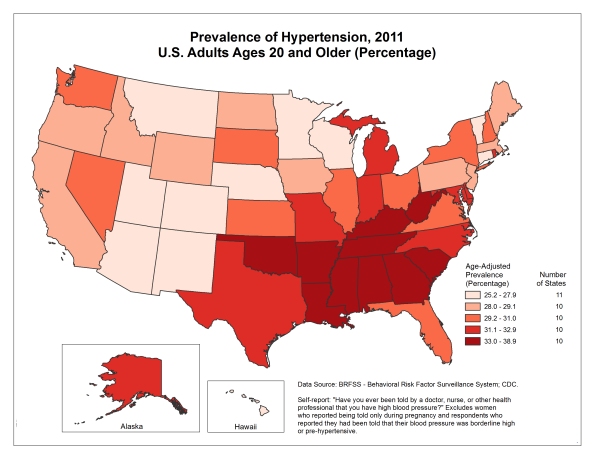![]() Cholesterol
Cholesterol
![]() Heart Disease
Heart Disease
![]() High Blood Pressure
High Blood Pressure
![]() Hypertension
Hypertension
![]() Men Heart Disease
Men Heart Disease
![]() Women Heart Disease
Women Heart Disease
![]() HOME
HOME
![]()
High Blood Pressure Fact Sheet

Source: CDC, Behavioral Risk Factor Surveillance System.
High Blood Pressure Facts
- Having high blood pressure puts you at risk for heart disease and stroke, leading causes of death in the United States.
- High blood pressure was a primary or contributing cause of death for 348,000 Americans in 2008, or nearly 1,000 deaths a day.
- 67 million American adults (31%) have high blood pressure—that’s 1 in every 3 American adults.
- 36 million American adults with high blood pressure don’t have it under control.
- About 30 percent of American adults have pre hypertension—blood pressure measurements that are higher than normal, but not yet in the high blood pressure range. Having prehypertension raises your risk of developing high blood pressure.
- High blood pressure usually has no warning signs or symptoms, so many people don't realize they have it.
- Reducing average population sodium intake from 3,300 mg to 2,300 mg per day may save 18 billion health care dollars and reduce cases of high blood pressure by 11 million annually.
- High blood pressure costs the nation $47.5 billion annually in direct medical expenses and $3.5 billion each year in lost productivity.
Blood pressure is written as two numbers. The first (systolic) number represents the pressure in your blood vessels when your heart beats. The second (diastolic) number represents the pressure in your vessels when your heart rests between beats.
| Blood Pressure Levels |
|
|---|---|
| Normal |
systolic: less than 120 mmHg diastolic: less than 80mmHg |
| At risk (prehypertension) |
systolic: 120–139 mmHg diastolic: 80–89 mmHg |
| High |
systolic: 140 mmHg or higher diastolic: 90 mmHg or higher |
CDC's Public Health Efforts
Million Hearts™
Million Hearts™ is a national, public-private initiative of the Department of Health and Human Services to prevent 1 million heart attacks and strokes by 2017. Co-led by CDC and the Centers for Medicare & Medicaid Services, the initiative brings together communities, health care professionals, health systems, nonprofit organizations, federal agencies, and private-sector partners to improve care and empower Americans to make heart-healthy choices.
CDC's National Heart Disease and Stroke Prevention Program
Since 1998, CDC has funded state health departments' efforts to reduce the number of people with heart disease or stroke. Health departments in 41 states and the District of Columbia currently receive funding. The program stresses policy and education to promote heart-healthy and stroke-free living and working conditions.
WISEWOMAN
CDC funds 21 WISEWOMAN projects in 19 states and two tribal organizations. WISEWOMAN helps women with little or no health insurance reduce their risk for heart disease, stroke, and other chronic diseases. The program assists women age 40 to 64 in improving their diet, physical activity, and other behaviors. WISEWOMAN also provides blood pressure tests and other screening.
